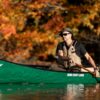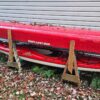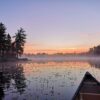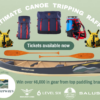tanding at the edge of Wilberforce Falls (Kattimannap Qurlua) was a dream first held by Trace Dunning when he was a college freshman who spent his spare time on canoe tripping forums and exploring Arctic rivers on Google Earth. Trace, a long time camper – then counsellor and trip leader – at Minnesota’s Camp Kooch-i-Ching, had a plan to make it a reality. It was becoming tradition amongst the more hardcore camp alumni to put their canoe tripping skills to the test in the Canadian Arctic. In 2019, Trace built an epic 60 day route with Wilberforce Falls as its centrepiece and started assembling a team of six paddlers, with the goal of completing the trip in 2021. When the pandemic prevented them from entering Canada their plans were waylaid. The trip lost momentum when original team members dropped off as the pandemic dragged on and life took them in other directions.
In 2023, Trace connected with fellow Kooch-i-Ching trip lead Roger Miller about getting the plan back on track. They put together a new team of current and former camp staff who ranged in age from 22-30: Trace Dunning, Roger Miller, Kieran Malloy, Matt Collins, Zak Armacost, and Harry Shook. They called the trip “The Centennial Expedition” to commemorate the 100th birthday of Kooch-i-Ching, the source of their friendship and of their love for wilderness adventure. While they each had personal reasons for embarking on the Centennial Expedition they also had a shared goal to give back by raising funds and awareness for the Camping & Education Foundation, the parent organization of Kooch-i-Ching, which includes an Urban Wilderness Program that fosters urban youth’s ability to access nature and outdoor education. This fall I connected with Trace, Roger, Harry and Zak by phone to talk about their trip.
The route: Fort Smith > Slave River > Great Slave Lake > Pike’s Portages > Artillery Lake > Lockhart River > Ptarmigan Lake > Clinton Colden Lake > Aylmer Lake > Thonokied River >Lac de Gras > Coppermine River > Point Lake > Coppermine River* > Fairy Lake River > Napatulik Lake > Hood River > Bathurst Inlet, Arctic Ocean
*Day 40 re-supply point
What motivated you to participate in the expedition? Describe your “why”.
Zak: Initially, it was seeking challenge, but as I progressed through the trip that changed: Rather than seeking an objective, just being out there for so long forces you to slow down and appreciate being out there for the value that has in itself. It really allowed for me to disconnect and reset.
Trace: Being able to do to the trip in general after planning for so long really felt like a dream come true. Beyond that I had a personal goal to catch a lot of fish – I caught lake trout, walleye and arctic char. Mostly catch and release, but we did filet and eat a few.
Roger: The challenge of such a remote and beautiful canoe trip really appealed to me. We didn’t see another person for 45 days – it was an incredible experience. On a deeper level I viewed the trip as a transition from my twenties into my thirties… the experience ended up being more of a meditative and reflective process. I sat in the canoe for 8-10 hours a day, and we didn’t really talk while paddling, so I had a lot of time to think. It was such a special experience to really reflect on what I want to get out of the next phases of my life.
How do you think your experiences at Kooch-i-Ching prepared you to take on this expedition?
Zak: In every aspect. There are very few places on earth that can give you as good an outdoor education experience as Kooch-i-Ching can. It teaches resilience, overcoming physical and mental adversity, plus all of the hard skills like trip planning and navigation, how to use your gear, etc.
Harry: Camp gave us the desire and motivation to commit to an undertaking like this, but also the mentors – like 6 North of 60 – who planted the seed of this Arctic expedition dream and who showed us that it was possible. And of course the hard skills to make the trip happen: from the logistics and planning before to the physical ability to execute the route.
In what ways was this different from other trips you’ve done
Zak: The logistic intensity of the trip from a planning and prep perspective.
Harry: The group cohesion in terms of our motivation and willingness to do whatever it took to get to our float plane pick up location on time.
Biggest challenge of the trip?
Zak: The hardest part for me was being ice bound. We spent a total of 6 days icebound on Artillery Lake: the ice was too thin for us to walk on and too thick to break up with the boats. We had to accept that pushing forward wasn’t worth the risk, but it was a real test mentally to just sit there and wait, knowing how much harder it would make the rest of the trip. Every day that we waited the daily mileage we would need to hit to meet our float plane on day 60 got higher and higher. It was daunting for sure.

Pike’s Portages
Harry: Moving out of Great Slave Lake we had a portion called Pike’s portages. We had anticipated it being hard – it’s back to back to back portages. But we hit that around day 16/17 and still had almost 30 days left of food to carry on our backs. The first portage was like 3.5 miles with a ton of elevation change and a ton of heavy gear. We each had to make three full trips on that first portage, for about 21 miles in total.
Roger: The most challenging section of the route was right in the middle, around day thirty – when we had to drag up the Thonokied River. It was an unexpected challenge: we were not anticipating that we would have to spend three days dragging our boats up a river with strong current, waist deep water, tons of bugs, tons of rain. It was pretty miserable the whole time. Not only was it physically challenging but it was really tough on morale.
Trace: We referred to the second third of the trip as “The Darkest Third”. This was the most mysterious part of the route, because there were the fewest trip logs. Not many people had done it before. It involved miles upon miles of dragging along shallow rocky class II rapids. It was cold and wet; we hadn’t seen the sun in a week. That was really challenging from a group morale standpoint.
Most rewarding moment of the trip
Harry: The most rewarding was getting to Wilberforce falls, about 20 miles from the Arctic ocean on the Hood. Getting to this falls was our main goal of the trip and we had some long push days to make it there on time. To end up succeeding and to know we were so close to the end was a crazy feeling. The canyon and the falls themselves are truly breathtaking. It will probably always remain one of the most beautiful things I’ve ever seen.
Roger: Our last day of paddling on the Hood river leading into Wilberforce falls was absolutely the highlight for me. Just nonstop, amazing whitewater paddling. We knew from the map that up until Wilberforce everything was runnable. We felt super confident with how the boats were outfitted and we were all so in rhythm with our paddling partners that we were just zipping down the river, not needing to stop and scout – such a fun experience.
Trace: Pulling up to Wilberforce falls and hearing it form a distance on the second last day made all the hard work and long days worth it. That’s when I realized we were going to finish and make it.

Overlooking the canyon on day 59
Biggest takeaway?
Zak: Just to slow down – in terms of my everyday life but also in the tripping context just enjoy yourself and take a deep breath. From a logistical standpoint: food is so, so important. We brought way more than we needed. We had to finish the trip in 60 but brought 72 days of food. Eating the same dehydrated meals over and over became really repetitive. If I could do it again I would have started dehydrating food 6 months earlier and doubled the variety of the meals we had.
Harry: My takeaway is an immense amount of gratitude: for my own capabilities, and in pushing myself to do beyond what I thought possible. But also for having a bed to sleep in, and access to food, and for my family and support system.
Roger: How good it feels to slow down and live in the moment.
What personal item or piece of gear proved to be essential or helped keep you sane throughout the trip?
Zak: For me it’s an Exped widget – it’s a combo battery bank/lantern/fan I used to blow up my sleeping pad. And my kindle kept me sane – I read like 15 books on the trip.
Harry: I brought a really high quality hand cream. My hands, especially in the first three weeks of the trip, were calloused, dry, and sunburnt. Being able to put a hand cream on at night was a moment of luxury that felt by the end of the trip like an essential. It gave me something to look forward to at the end of every day.
Another non-essential piece of gear – that we almost didn’t bring actually – was our drone. Not only did it give us some incredible footage to bring home, but it became a really helpful navigational tool when we were icebound, helping us figure out where routes through the ice were opening up.
Roger: Probably a sleeping mask. This was a last minute purchase but really improved the quality of my sleep out there – especially with the midnight sun.
Trace: My fishing poles, my Kindle. And of course our Nova Crafts. We beat the everloving hell out of those boats. From busting through ice on Great Slave Lake, banging into rocks, dragging them upstream and portaging them for miles: I think we put them through every test you could put a canoe through and they held up beautifully.

The Centennial Expedition fleet: Nova Craft Canoe Prospectors (2 x 17′, 1 x 16′) in TuffStuff Expedition
What advice would you give to someone else doing this route?
Zak: If they were doing the exact same route I’d tell them:
- Start later to avoid getting icebound
- Don’t underestimate Pike’s (it’s insanely hard)
- Prepare yourself for many days of upstream dragging
- Use Nova Crafts. We brutalized those boats and I’m amazed at how well they held up.
Harry: My advice is just to seize the opportunity. It’s truly once in a lifetime.
Roger: That the grant writing, logistics, sponsorship-seeking and planning phases are the most difficult slogs of the whole trip. Remain motivated to complete the logistical side knowing that it will be worth it in the end.
Trace: Find yourself a really good team. There’s no way I could have pulled this off if I had done everything by myself – the team really pulled through: Zak and Harry planned and managed all of our food, which is a massive undertaking. Roger’s hard skills in whitewater paddling were a huge asset – and just being a more mature presence was great to have around. We really needed Matt Collins’ demeanor on trip: he’s so funny and lighthearted; he kept a smile on our faces even through the toughest days. And Kieran took on our social media and sponsorships, so he helped make the trip possible from a money standpoint. It’s a cliché but I really couldn’t have done it without these guys.

Harry, Kieran, Matt, Trace, Zak, and Roger







